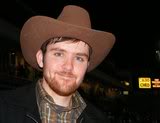While speaking to the Alberta Association of Municipal Districts and Counties this week, Premier Ed Stelmach confirmed the obvious when defending his government's decision to increase the number of constituencies in the next election: it was in order to preserve the existing number of rural constituencies in the Legislative Assembly. This decision continued the over-represention of rural Alberta ridings in the Assembly, despite rapid growth in the urban centres.
With a few exceptions, the PCs have been able to rely on non-competitive electoral districts in rural Alberta since wiping out the Social Credit rump in 1975. Over the past 39-years, the PCs have relied heavily on rural politicians as a "farm team" to replenish their ranks of rural MLAs (some now include Premier Stelmach, and Ministers Jack Hayden, Iris Evans, Ray Danyluk, Lloyd Snelgrove, Mel Knight, and MLAs Wayne Drysdale, Broyce Jacobs, Richard Marz, and Len Mitzel).
The PCs have dealt with competitive elections in the two major urban areas (Edmonton and Calgary), but the threat of a Wildrose insurgency across Alberta would be cause for great concern and is likely the reason behind Premier Stelmach's posturing over rural over-representation.
Thursday, March 18, 2010
the rural alberta advantage.
Posted by daveberta at 10:14 PM 7 comments Links to this post
Labels: Broyce Jacobs, Ed Stelmach, Iris Evans, Jack Hayden, Len Mitzel, Lloyd Snelgrove, Mel Knight, Ray Danyluk, Richard Marz, Wayne Drysdale
electoral boundaries mashup.
Earlier this week, I posted the poll-by-poll results from the 2008 provincial election for Calgary and Edmonton, and (once again thanks to reader Alan Hall) posted below are the 2008 results superimposed over the proposed boundaries from the interim report of the Electoral Boundaries Commission. A listing of the interim ridings with the 2008 results and margins are also posted below. If the political environment continues to change before the expected 2012 election, the past electoral results could mean very little, but until that time, these maps provide an interesting view of the previous election and what could be in 2012:

Posted by daveberta at 9:56 PM 5 comments Links to this post
Labels: Broyce Jacobs, Ed Stelmach, Iris Evans, Jack Hayden, Len Mitzel, Lloyd Snelgrove, Mel Knight, Ray Danyluk, Richard Marz, Wayne Drysdale
Tuesday, March 16, 2010
wayne cao sings.
I am speechless... and unsure how I missed this until now. Calgary-Fort MLA Wayne Cao sings on YouTube... could it be the next trolololololo?
Monday, March 15, 2010
interim electoral boundaries report attracts some interesting responses.
An NDP letter writing campaign to change the name of a northern riding to Notley-Central Peace, at least two messages sent from a Blackberry, and a hand-written congratulatory note from Minister Iris Evans are among the many Spring 2010 submissions to the Electoral Boundaries Commission. The Commission recently published its interim report and maps, and is set to hold its second round of public hearings on April 12 to 30, 2010.
For readers interested in the political implications of the changes, thank reader Alan Hall, who emailed me these Calgary and Edmonton maps and poll-by-poll results from the 2008 election (data provided by Elections Alberta). It would be interesting to see these poll results transposed on the interim boundaries and the final report boundaries (due in July 2010).
Posted by daveberta at 11:17 PM 4 comments Links to this post
alberta political notes 3/15/2010
- New polls from Angus-Reid (Wildrose: 42%, PC: 27%, Liberal: 19%, NDP 9%, Other 3%) and Environics (PC: 34%, Wildrose: 30%, Liberal: 23%, NDP 10%). Calgary Grit has more on these polls.
- According to the PC Party website, Patricia Godkin has replaced Jim Campbell as Executive Director (Mr. Campbell recently joined Cenovus Energy as their Vice-President Government Relations and Corporate Accountability). Ms. Godkin previously served as Director of Finance and was the acting Executive Director in 2007 after the resignation of Peter Elzinga. While holding the interim position in 2007, Ms. Godkin faced a challenge from outgoing PC Youth President David McColl, who published an op-ed in the Calgary Herald predicting that "PC Alberta will continue its slow death march, to the beat of a rural drum and tired, stale policies."
- Vitor Marciano is expected to become the new Executive Director of the Wildrose Alliance. Mr. Marciano recently stepped down from his position on the National Council of the Conservative Party of Canada and served as Campaign Manager for Edmonton-Centre MP Laurie Hawn in 2004 and 2006, and for Nunavut MP Leona Aglukkaq in 2008. In 2006, he supported former Edmonton-McClung PC MLA Mark Norris' bid for the PC leadership. This is the second prominent Edmonton conservative to join Danielle Smith's staff in recent months. In February, former PC Party VP Outreach and 2004 Edmonton-Strathcona candidate Shannon Stubbs became Executive Assistant to Ms. Smith.
- Former Edmonton-Meadowlark Liberal MLA Maurice Tougas has written a piece in this month's Alberta Views Magazine that focuses on Danielle Smith's time on the Calgary Board of Education from 1998 to 1999. Mr. Tougas' reliance on comments from former Trustee Jennifer Pollock provided a fairly one-sided perspective of the issue. You can read my four part series Smith v. Board of Education part 1, part 2, part 3, and part 4.
- The Alberta Party has posted an update on The Big Listen.
- Tyler Shandro has raised some interesting questions about the interim report of Alberta's Electoral Boundaries Commission.
- Three years after the a committee of top-tier economic experts recommended increasing the royalty rates collected by the provincial government, Premier Ed Stelmach has cut back the amount of resource royalties that are collected. The Pembina Institute responded by pointing out that "Albertans, the owners of the province's oil and gas resources, were completely left out of the process of reviewing Alberta's royalty rates."
Posted by daveberta at 8:43 AM 15 comments Links to this post
Labels: Danielle Smith, David McColl, Ed Stelmach, Jennifer Pollock, Jim Campbell, Laurie Hawn, Leona Aglukkaq, Maurice Tougas, Patricia Godkin, Peter Elzinga, Shannon Stubbs, Vitor Marciano
Saturday, March 13, 2010
closing inner city schools in edmonton.
The threat of proposed school closures in inner city Edmonton has once again riled opposition MLAs into a frenzy on the floor of the Legislative Assembly. Declining student enrollment has led to Edmonton Public School Board to propose the closure of 11 inner city schools in January 2010 (Delton, Eastwood, John A. McDougall, McCauley, Norwood, Parkdale, Spruce Avenue, Capilano, Fulton Place, Gold Bar and Hardisty). It is difficult not to sympathize with the pleas of these MLAs' constituents, but each time that an opposition MLA rises to demand an answer from the Minister of Education about these closures the issue gets more muddied.
Edmonton-Highlands-Norwood MLA Brian Mason:
"many schools in the inner city are in danger of being forced to close as the number of schools in Edmonton’s suburbs expand."The proposed school closures have very little to do with the provincial government or the Department of Education and more to do with how our cities have grown over the past forty years. Edmonton's Public School Trustees are ultimately responsible for the fate of these schools and the reality is that young families are not moving into the inner city in the numbers needed to keep these schools operating. They are moving to the suburbs and to the outlying municipalities in the Capital region, which have experienced unbridled urban sprawl in recent decades. The reality is that there is a market demand for single-dwelling residential properties (contributed to by both cost and the desire to have a detached home with a yard).
Having grown up in one of Edmonton's outlying communities, I can testify that it was a great environment to be raised. As someone who has lived in the urban core since moving to Edmonton, I know that there are some areas that I would not want to raise my children. This said, continued urban sprawl is not a solution to Edmonton's growth challenges. The further our city sprawls, the more expensive it will be to provide the kind of services that are idealized. Urban sprawl is unsustainable.
Edmonton-Gold Bar MLA Hugh MacDonald:
"If the city of Edmonton increases population density in the central neighbourhoods as planned, we will need the student spaces now being considered for closure."Inner city communities, like Alberta Avenue, have taken exceptional steps to challenge stereotypes and create more family friendly environment in their neighbourhoods. New residential and commercial development in downtown Edmonton as well as the development of the City Centre Airport lands over the next 20 to 30 years could create an inner city renaissance that could breath new life into Edmonton's inner city schools.
If Edmonton's urban core does witness a population density increase that attracts more young families, it is very likely that these school buildings, could be available to be reopened. As far as I am aware, it is undetermined what would be done with these proposed closed schools. Kevin Kuchinski has written a blog post on the potential usages for these schools if closed.
Well-funded special interests like the Katz Group have been focusing their energies on convincing Edmontonians that the urban core would be revitalized through the public funding of a new arena. A new arena could have some economic benefits to the downtown core, but it does not address the larges societal issues facing the core or how our cities are growing. If urban sprawl is unsustainable, what are our municipal leaders doing to create an inner city that is friendly and welcoming to young families? Urban sprawl is the root cause of the school closures decision facing our elected School Board Trustees.
When School Trustee and City Council candidates start knocking on doors before the October 18, 2010 elections, Edmontonians who care about the future of our inner city neighbourhoods should remember that the school closures are not the result of a nefarious political agenda, but a result of how we have let our city to grow.
Tuesday, March 09, 2010
alberta political notes 3/09/2010
- Jokes about politicians ducking responsibility usually aren't literal. Premier Ed Stelmach first denied seeing the widely covered photos of the now infamous oil-covered Syncrude ducks. His communications armada then changed the story, claiming that the Premier misunderstood the question and has seen the photos. Next question: How do you feel?
- Edmonton City Councillor Don Iveson shot back at Minister Luke Ouellette over the neutered Green Trip Fund. Premier Stelmach originally promised $2 billion for the fund in 2008, but it was later cut back to $520 million over three years. Since 2007, the City of Edmonton has made major investments into improving and expanding the capital city's transportation infrastructure.
- The United Nurses of Alberta have opened negotiations with Alberta Health Services. UNA entered negotiations with a reasonable short list of proposals addressing key issues for nursing in Alberta. Alberta Health Services responded with a full proposal document that included an unprecedented number and scale of rollbacks (Transparency Alert! I am employed by UNA).
- AHS CEO Stephen Duckett versus Minister Gene Zwozdesky and Premier Stelmach on "pay for performance" and the Tom Baker Cancer Centre? Is Dr. Duckett trying to get fired? Who is steering the ship? It has certainly put Don Braid in a tizzy.
- With Calgary Mayor Dave Bronconnier on his way out of the Mayor's Office, can Calgarians expect a Ric McIver - Naheed Nenshi showdown? Will former Calgary-Nose Creek MLA Gary Mar return from Washington DC to take a run for the job?
- Liberal MLA Kent Hehr running for Mayor might be an inside joke, but how about his counterpart Dave Taylor? Word on the street is that the Calgary-Currie MLA and former radio star is growing tired of playing second fiddle to Liberal leader David Swann. Taylor was thrown a bone when he was tapped to launch the new Liberal energy policy in January, but rumor has it that Taylor's organization has been constantly challenging Swann and that the situations is tense inside the Liberal caucus. Confrontation may come to a head at the May 2010 Liberal Party convention.
- A battle is shaping up for the federal Conservative Party nomination in Lethbridge. Nomination candidates include Jim Hillyer and Mark Switzer are seeking their party's nod. Conservative MP Rick Casson has represented the riding since 1997 and was re-elected in 2008 with 67% of the vote.
- Former Edmonton-Strathcona MP Rahim Jaffer pleaded guilty to careless driving in an Ontario court, but charges of cocaine possession magically disappeared. Mr. Jaffer was sentenced to a $500 fine.
- I was interviewed by Edmonton Journal editor Sheila Pratt for a feature article that was published this part weekend on Reboot Alberta. The article also features comments from Ken Chapman, Shannon Sortland, David Maclean, NDP MLA Brian Mason, and Liberal MLA Hugh MacDonald - who accused to the group's participants of being "elitist." Andrew McIntyre rebutted Archie McLean's suggestions that Reboot Alberta could become a debate society. I ask: would a real debate society be a bad thing?
Posted by daveberta at 6:30 PM 20 comments Links to this post
Labels: Brian Mason, Dave Taylor, David Swann, Don Iveson, Ed Stelmach, Gary Mar, Gene Zwozdesky, Hugh MacDonald, Kent Hehr, Luke Ouellette, Naheed Nenshi, Ric McIver, Stephen Duckett
Sunday, March 07, 2010
photo post: jasper avenue from 97th to 124th street
This weekend, I took a stroll along Edmonton's Main Street - Jasper Avenue - starting on 99th Street through 124th Street in downtown Edmonton. I brought a camera with me and took some photos along the way (check out Flickr for more).


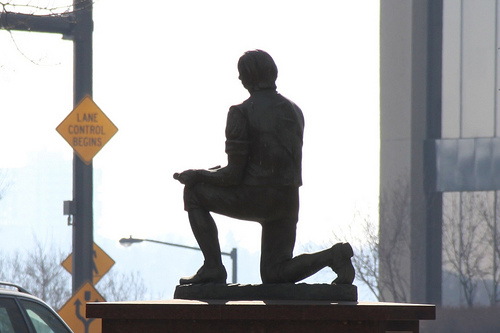


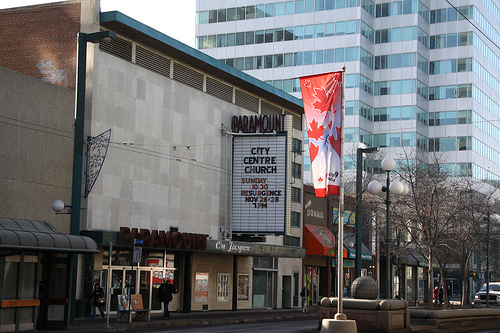




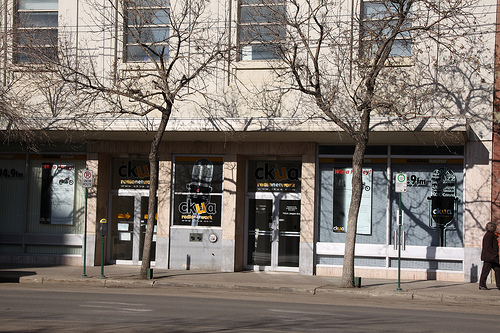
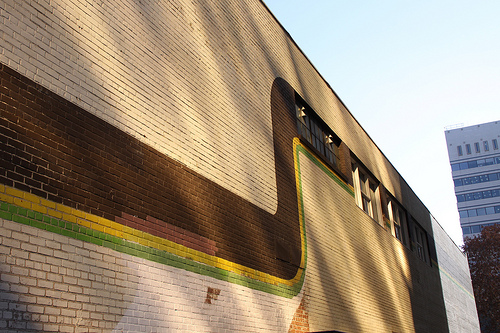
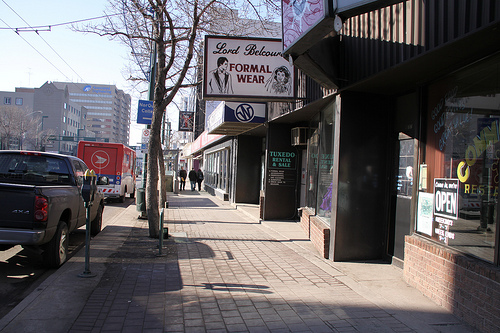

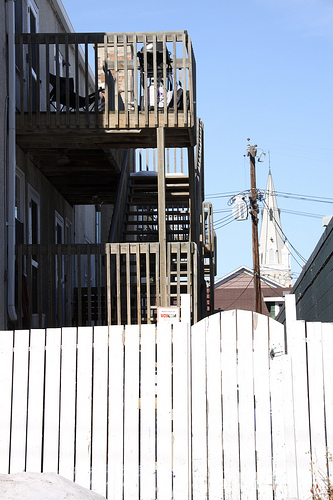
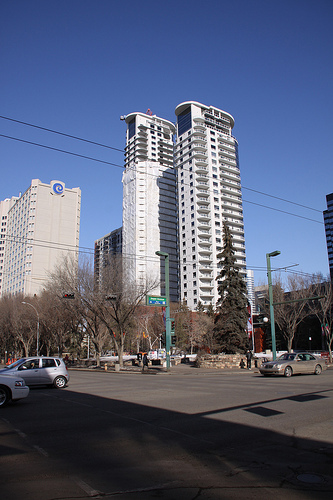
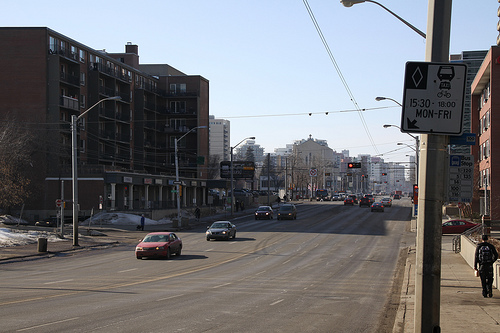
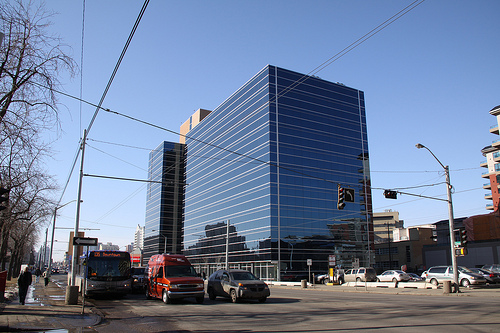
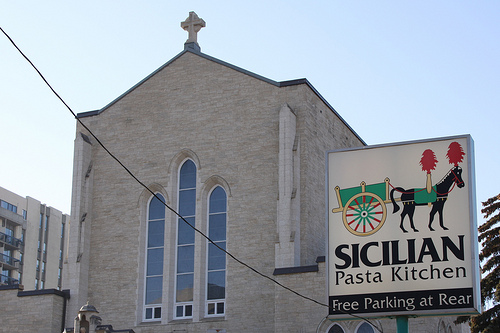
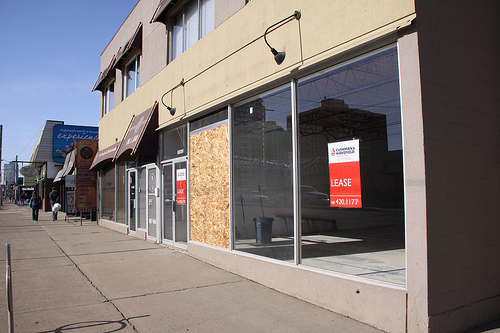
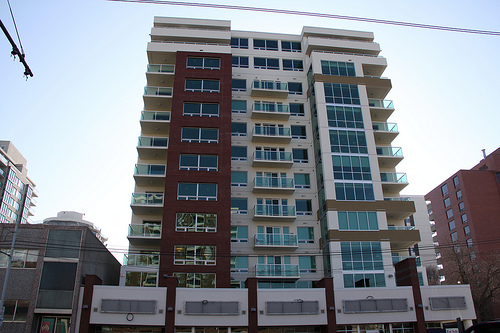
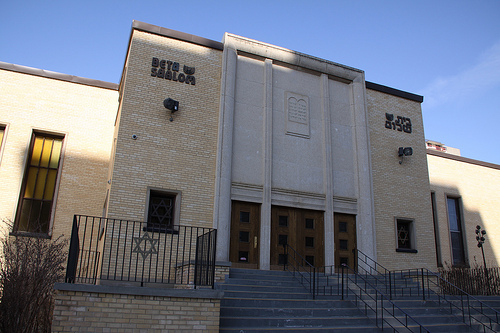
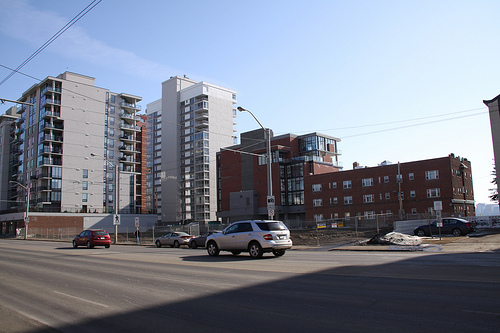

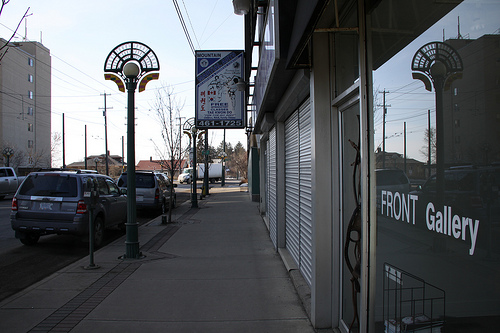
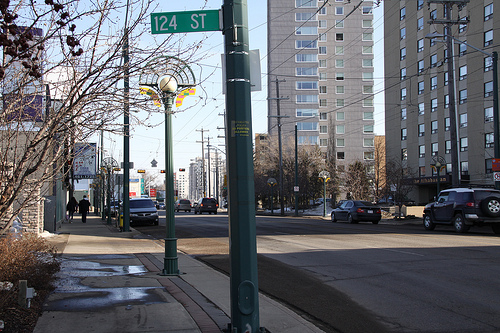
Posted by daveberta at 10:15 PM 11 comments Links to this post
Labels: Downtown Edmonton, Jasper Avenue, Photo Post
Saturday, February 27, 2010
does downtown edmonton need a katz arena district?
While I liked the video, Mr. Katz avoided the most important question of the exercise: money. It is no secret that the Katz Group would like the City of Edmonton to loan upwards of $400 million towards a new downtown arena, likely making it the largest non-transportation-related one-time investment that our municipality will have ever made (Councillor Don Iveson recently explained the funding request issue more articulately than I ever could here and here).
Aside from the political spin, I welcome a wider public conversation and am excited about the potential for a real debate about downtown. There are those people who are stuck in the 1980s and 1990s mentality that downtown Edmonton is a barren wasteland of warehouses and closed down rail yards, and then there are those Edmontonians who have moved on and seen the evolving character of our downtown core. The Katz Group campaign could generate competing ideas and a real discussion about what kind of face Edmontonians want our downtown to wear.
Downtown Edmonton (what I describe as the area between 100 Street and 124 Street) is a drastically different place than it was ten years ago. From the time when I first lived downtown in 2003 to when I moved back in 2009, I am excited by the changes that I have witnessed. New condo developments in the Oliver and Grandin have created a new identity in those neighbourhoods. People are moving into the core of the city and enhancing its diversity. Walk down Jasper Avenue west of 109th Street on a summer night and you will bump into many people coming in from the restaurants, bars, and coffee shops. The 104th Street Farmers' Market is a perfect example of the vibrant new identity of Edmonton's downtown core.
The business district of downtown Edmonton is like many other commercial business districts: employees leave work and it closes down at 6pm. This is the purpose of a commercial district dominated by office towers. An arena is not going to change this. An arena district north of downtown developed on clear urban development concepts could help revitalize a rougher part of the downtown core.
I have heard many arguments about how a downtown arena could revitalize the area, but I have not been convinced that our current arena, Rexall Place, is as bad as its detractors would characterize it. Admittedly, I have only been inside Rexall Place about a dozen times over the past ten years (mostly during the Canadian Finals Rodeo). While this is the case, I don't fully understand why it needs to be replaced so badly. As a friend pointed out to me yesterday, 'because it is old' isn't a very good argument.
Although the idea of a downtown "arena district" intrigues me, any new development must be based in solid urban development concepts, and not in emotional appeals from politically and financially motivated individuals.
I welcome a real conservation about downtown Edmonton. Let's start it!
Posted by daveberta at 2:55 PM 14 comments Links to this post
Labels: Daryl Katz, Don Iveson, Ed Stelmach, Joan Forge, Peter Elzinga, Ralph Klein
Wednesday, February 24, 2010
alberta's proposed new electoral boundaries (interim report)
The Electoral Boundaries Commission has released their interim report including maps of the proposed electoral division boundaries for the next election. Here are the proposed maps of Calgary, Edmonton, and Alberta-wide.
UPDATE (February 27, 2010):
Overall, I feel that the interim maps are a fairly good report from the Electoral Boundaries Commission. Given that the Commission had a legislative mandate to increases the number of electoral districts from 83 to 87, the members of the Commission likely had a much easier time deciding boundaries than had the number stayed the same or decreased. Here are some thoughts:
- I am pleased to see that the City of Grande Prairie would now have its own fully-urban riding and that Fort McMurray now has two districts.
- Edmonton received an additional electoral district, which places the Capital City at the same position it was before it lost a district during the 2003 boundary review. I would have liked to see Edmonton receive at least two new seats.
- Are voters in the Capital Region outside of Edmonton disenfranchised? I have always questioned the reasoning behind clumping Edmonton's bedroom communities like the Town of Morinville into electoral districts with Barrhead and Westlock, and Sturgeon Valley with Athabasca. Having grown up in Morinville, I can attest that there is little commonality between the three communities (I would estimate that around 90% of Morinville residents commute to work in Edmonton or St. Albert). It would make more sense to include these communities in a Sturgeon Valley district that included common communities in the Capital Region (the same can be said of Fort Saskatchewan-Vegreville).
- From a political perspective, these interim maps would pose a political challenge to some incumbent MLAs. For example, Battle River-Wainwright MLA Doug Griffiths may have to face-off in a nomination contest with Drumheller-Stettler MLA Jack Hayden. The additional electoral district in Fort McMurray could also make it easier for Independent MLA Guy Boutilier bid for re-election.
- Once again, the Poland of Alberta's electoral map, Edmonton-Calder would disappear as it is merged with Edmonton-Glenora, Edmonton-North West, and Edmonton-Le Perle. This would pose a challenge to current Edmonton-Calder PC MLA Doug Elniski and former NDP MLA David Eggen (who many people expect to seek election in 2012).
Once again, the second round of public hearings begin in April 2010, so if you do not like what you see in these maps, show up and let yourself be heard!
Posted by daveberta at 3:50 PM 32 comments Links to this post
alberta political notes 2/24/2010
- As Bill 1, the Alberta Competitiveness Act is this sessions flagship piece of government legislation. With all the focus on "competitiveness," has anyone wondered what happened to the Premier's Economic Strategy Committee that was announced last summer? (their website has not been updated since July 2009) The committee included former Deputy Prime Minister Anne McLellan, former MP David Emerson, and former Bank of Canada Governor David Dodge.
- Calgary Mayor Dave Bronconnier announced that he will not be seeking re-election in October. Bronconnier was first elected as Mayor in 2001. Edmonton Mayor Stephen Mandel has yet to make his electoral intentions public.
- Alberta could hold its fourth Senate election since 1989 along-side the municipal elections this October.
- Edmonton City Council approved the Municipal Development Plan this week. Councillor Don Iveson has posted some remarks on his blog.
- Lethbridge-East MLA Bridget Pastoor scored a win for the Liberal Opposition this week when the Assembly approved her motion to "...urge the Government to establish an independent Commission to review the current salaries and benefits for Members of the Legislative Assembly..." It is important to note that as this was a Private Member's Motion, it is non-binding.
- Facing charges of cocaine-possession and drunk-driving, former Edmonton-Strathcona Conservative MP Rahim Jaffer is expected to plea-bargain when his case reconvenes in March.
- In my previous post, I mentioned the low-voter turnout in the 2008 provincial election. Here is a map showing voter turnout in ridings across the province (only 4 out of 83 ridings had a turnout larger than 50%).

Posted by daveberta at 8:15 AM 2 comments Links to this post
Labels: Anne McLellan, Bridget Pastoor, Dave Bronconnier, David Dodge, David Emerson, Don Iveson, Rahim Jaffer, Stephen Mandel
Monday, February 22, 2010
alison redford's big opportunity.
(Re)Enter Mister Fjeldheim.
There has been a certain amount of attention focused on Alberta's Chief Electoral Officer and his comments regarding his philosophy towards his newly re-inherited position. Brian Fjeldheim, who held the position from 1998 to 2005, was recently reappointed following the dismissal of his more activist successor-turned-predecessor Lorne Gibson. After re-assuming his role last week, Mr. Fjeldheim was a little more reserved when describing his role in advocating the importance of the vote to Albertans (60% of Albertans did not vote in the 2008 election). Dave Breakenridge offered some thoughts on Mr. Fjeldhiem's comments in today's Calgary Sun.
Open up the Elections Act.
In the next few weeks, Justice Minister Alison Redford is expected to introduce legislative amendments to Alberta's aging Elections Act. Minister Redford has said that the amendments will include some of the 182 recommended changes submitted by Mr. Gibson before his departure (but will not include fixed election dates). Of course, the recommendations included in the Bill will have be carefully chosen and measured for political impact by Minister Redford and her PC cabinet colleagues. Minister Redford's amendments will likely include changes to how Returning Officers are chosen. During the 2008 election, it was revealed that the PC Party had provided lists of candidates for Returning Officers to the Elections Office (over half of the appointed Returning Officers had partisan connections to the PC Party).
Elections procedures can be improved through legislation, but democratic participation can be strengthened through meaningful engagement. In September 2007, the Government of New Zealand tried something completely different. As an innovative way to capture the views of the public on what a new Policing Act should look like, the Ministry of Justice launched an online Wiki. This Wiki allowed citizens from across that country to contribute their ideas and collaborate in the creation of new legislation.
What better way to reinvigorate our Elections Act than by opening up the amendment process to allow Albertans to collaborate by contributing their ideas for changes and improvements? What better opportunity to do things differently in than by allowing Albertans to invest their own ideas into the development of the important piece of legislation that will decide how their elections are structured? Is there a more meaningful piece of legislation that could be opened up to public collaboration than the Elections Act? Would this kind of online collaboration succeed in Alberta? There is only one way to find out.
Prior to entering elected office in 2008, Minister Redford cultivated an international legal career helping build democracies in countries around the globe (including as one of four international election commissioners appointed by the Secretary General of the United Nations to administer Afghanistan's first parliamentary elections in September 2005). Legislative amendments can improve structure, but opening up the Elections Act to real public collaboration could be Minister Redford's big opportunity to create more meaningful democratic participation in Alberta.
Making it easier for students to vote.
I am sure that there would be no shortage of Albertans who would contribute their ideas to an open dialogue on improving our Elections Act. The Council of Alberta University Students submitted a handful of recommendations (pdf) to Minister Redford last year when they heard about the upcoming legislative amendments. Each of the five recommendations have been adopted by Elections officials in provinces across Canada (though no jurisdiction has adopted all five). The recommendations would improve access to a voting demographic that due to its geographic transience, are likely to face barriers and challenges to participating in elections.

Coming Soon: New Maps.
Alberta's Electoral Boundaries Commission is due to release its interim report by February 26, 2010.
Posted by daveberta at 10:38 PM 6 comments Links to this post
Labels: Alberta Electoral Boundary Review, Alison Redford, Brian Fjeldheim, Lorne Gibson
Sunday, February 21, 2010
breakfast with the new alberta party.
I had a very interesting meeting over breakfast at the SugarBowl on Saturday morning with some of the members involved in the new Alberta Party. Most Albertans probably did not even know that an Alberta Party even existed. Most Albertans would probably be surprised at what a busy couple of months it has been for the tiny political party that has so far occupied a historical footnote worth of activity.
Former Green Party Deputy Leader Edwin Erickson was collecting signatures to create a new 'Progress Party,' when he was approached to join the Alberta Party and run its leadership late last year. He was soon after acclaimed as Leader. Erickson is well-known in central Alberta for his opposition to the new transmission line laws (Bill 46, Bill 50, and Bill 19) and he placed a distant, but strong, second when running in the Drayton Valley-Calmar in the 2008 election.
Erickson was joined at our Saturday morning breakfast meeting by two new Alberta Party board members. Chris Labossiere is a successful businessman and is the former VP Communications for the Edmonton-Whitemud Progressive Conservative Association. He left the PC Party in 2009 after the Bill 44 controversy. David King is one of the few Albertans still involved in politics who was around the last time a change in government happened. As the MLA for Edmonton-Highlands from 1971 to 1986 and Minister of Education from 1979 to 1986, King was closely involved with building the PC Party under its first Premier Peter Lougheed. King was also one of the founding forces behind the similarly named, yet differently focused, Reboot Alberta.
The co-chair of Renew Alberta, who will be heavily involved as a spokesperson for the new Alberta Party, is Chima Nkemdirim, a lawyer from Calgary who until the last election was involved with the Liberal Party as campaign manager for Calgary-Buffalo MLA Kent Hehr. Taking a look at the list of the new Alberta Party board members revealed a healthy mix of very urban and very rural, and young and old with diverse political and community backgrounds. I know many of these people and have a lot of respect for what they are doing (I am told that the full list of board members for the new Alberta Party will be released when the new website is fully launched in March).
With the old party policies suspended, the new Alberta Party plans to focus their energies not on selling party memberships or building constituency organizations (at least now), but on 'The Big Listen' - a conversation with Albertans. Critical to their success is the need for 'The Big Listen' to be more than an exercise in faux-populism. We have seen a brand of faux-populism from the traditional political parties where they travel the province to "listen to Albertans" or hear "what Albertans want," only to return with a pre-determined partisan or ideological policy stance. In many ways, "listening to Albertans" has turned into an exercise in market research and brand development, rather than sincere governance. If the new Alberta Party is to be successful, "The Big Listen" needs to be a real exercise in collaborative policy development and ideas generation.
I was told that the new Alberta Party is planning to go beyond the traditional dreary town hall meeting to help supporters to host smaller and more intimate meetings in living rooms and seniors centres across Alberta. One of the ideas proposed at the breakfast meeting was the use of technology to create a collaborative atmosphere online where citizens can contribute beyond the on-going 'Big Listen' meetings.
As explained to me, the immediate goal for the people involved with the new Alberta Party is not to form government or to create another top-down leader dominated party, but to help change the culture of governance in Alberta. To "turn fear into hope and isolation into collaboration" by re-engaging Albertans in the way they are governed. If you think this sounds a bit like the language of ChangeCamp, you are correct. Some of the people involved in the new Alberta Party have also been involved or attended ChangeCamp in Edmonton, CivicCamp in Calgary, and Reboot Alberta.
Over breakfast, the example of Nokia was brought up. Responding to changing markets, the Finnish mobile phone company adopted an overlying strategy geared towards collaboration with their customers, rather than purely focusing on competition with other mobile phone companies. When this idea is applied politically, it is a large step away from the traditional confrontational mentality of annihilating your opponents at any cost. It should not be, but it is a novel idea, and not one that any of the traditional political are offering in any sincere way.
Throughout our discussion, the underlying theme I sensed from Erickson, Labossiere, and King was a desire for more accountable, transparent, and honest governance and a greater role for citizen engagement in how Albertans are governed. Essentially, an engaged, reformed, and accountable government reflective of the citizens of this province.
I have already heard harsh criticisms from friends in the PC, Liberal, and New Democratic parties that a new Alberta Party will only serve to split the centrist vote in the next election even further, helping the Wildrose Alliance to win more seats. There is a chance of this, but I have a difficult time seriously discussing vote splitting when 60% of Albertans did not vote in the last election. The traditional political parties have proven that they are uninterested or incapable of renewing themselves beyond what is politically most convenient in the short-term - and that is not good enough. As I wrote in response to comments in my previous post, maybe the new Alberta Party will flop, but maybe they will make politics more interesting (and more positive) for the average Albertan. I'm open minded and willing to give them a chance.
(You can find the Alberta Party online on Facebook and on Twitter)
Posted by daveberta at 9:09 AM 25 comments Links to this post
Labels: Chima Nkemdirim, Chris Labossiere, David King, Edwin Erickson, Kent Hehr, Peter Lougheed
Friday, February 19, 2010
peter, goldring "re" "hangs" louis, riel.
With commas as renegade as his description of Louis Riel, it is no wonder that Edmonton-East MP Peter Goldring missed the incredible syntax and grammatical errors in this December 2009 constituency mail-out.
Thursday, February 18, 2010
alberta party and renew alberta merge.
The joining of these two parties demonstrated the power of conversation. Over one weekend, two very different groups of people met to explore the vision we have for our province. We started by listening to each other, and in doing so we found remarkable commonality and we overcame our doubts. This is how the future of Alberta politics will be written.More to come, I am sure...
Albertans – whether young or old, urban or rural, labourers or professionals – have more in common than our current politicians give us credit for. While they would divide us along the political spectrum and pit us against one another, we refuse to ignore our shared history and our mutual values.
So where are our policies? As of today we have none. Unanimously our Board has decided to suspend our old policies and has committed to building new ones through face-to-face conversations, around the province, starting March 1st. The Alberta Party’s Big Listen is an Alberta-wide convention, with your kitchen table as its venue. By the time the next provincial election is announced, our party will reflect what your friends, your family – and you –have told us you’re looking for.
The Alberta Party has a strong legacy in Alberta and its roots run deep and wide. But we’ve never been more excited than we are today. We’re thrilled to join with the Renew Alberta movement, and we look forward to your help in getting all Albertans a better government.
We’re listening.
Edwin Erickson
Leader Alberta Party
Chima Nkemdirim
Co-Chair of Renew Alberta
Posted by daveberta at 11:45 PM 55 comments Links to this post
Labels: Chima Nkemdirim, Edwin Erickson



















